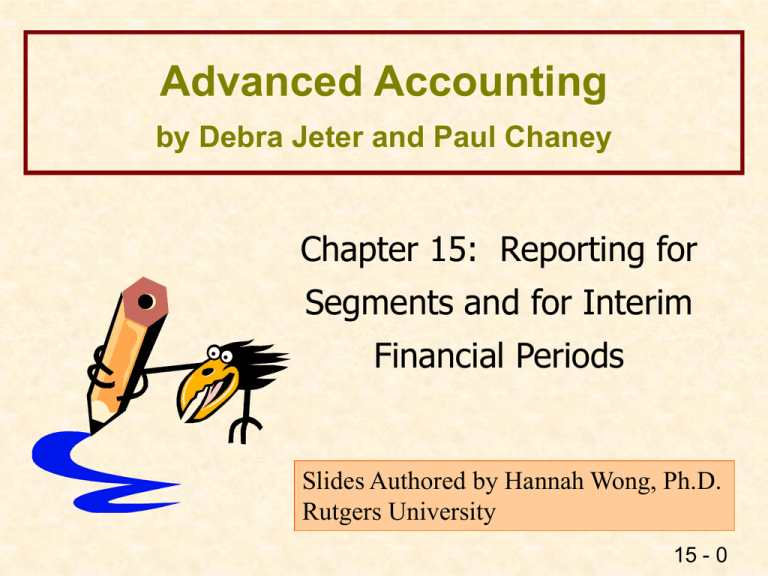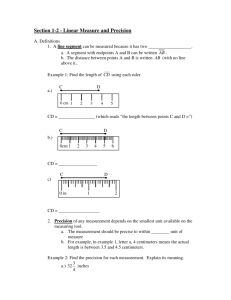
Advanced Accounting
by Debra Jeter and Paul Chaney
Chapter 15: Reporting for
Segments and for Interim
Financial Periods
Slides Authored by Hannah Wong, Ph.D.
Rutgers University
15 - 0
Need for Disaggregated Financial Data
Different industries or geographic areas
may have different
rates
of profitability
growth
types
opportunities
of risks
Difficult to analyze a firm engaging in
several industries or geographic areas
based on aggregated information
15 - 1
Segmental Disclosures
Advantage
unveiling
of information that has been merged in
the consolidated data
Disadvantages
may
be misleading due to classification and
allocation problems, lack of user knowledge, etc.
disclosure
to competing firms and labor unions
information
overload for users
15 - 2
Common Cost Allocation - Which?
Common costs should be
allocated to a segment for
external reporting purposes
only if they are included in
the segment’s internal
profit or loss calculations
15 - 3
Common Cost Allocation - How?
Steps
Joint costs are accumulated into logical
and relatively homogeneous expense
pools
The pools are allocated to segments on
the basis of beneficial or casual
relationships as measured by activity or
output of the segments
15 - 4
Common Cost Allocation - How?
Joint
costs
Expense
pools
Data processing
expenses
Centralized
warehouse
expenses
Segments
15 - 5
Operating Segment
Definition:
It is a component of the firm that engages in
business activities that earns revenues and
incur expenses
The entity’s chief operating decision maker
regularly reviews the component’s operating
results
Discrete financial information is available
15 - 6
Determining Operating Segments
Modified management approach
focus
on the way in which management
organizes segments internally to make
operating decisions and to assess
performance
aggregation criteria
quantitative thresholds
15 - 7
Aggregation Criteria
An entity is permitted to aggregate operating
segments which are similar in all the following
areas:
nature
of their products or services
nature
of the production process
types
or classes of customers
methods
services
nature
used to distribute products or provide
of regulatory environment
15 - 8
Quantitative Thresholds
A segment is significant enough to be a
reportable segment if :
combined external and internal revenue > 10%
of the combined external and internal revenue of
all reportable segments;
its
reported profit or loss > 10% of the total gross
profit (loss) of all operating segments reporting a
profit (loss); or
its
its
assets > 10% of combined assets of all
operating segments
15 - 9
75% Combined Revenue Test
Combined sales to
unaffiliated customers of
all reportable segments
Combined sales to
unaffiliated customers of
Must be
> 75%
all operating segments
If the 75% test is not met, additional segments must be identified
15 - 10
Segmental Disclosure Requirements
general
information
segment
operating profit or loss
segment
assets
bases
for measurement
reconciliation
of segment amounts
and consolidated amounts for
revenue
profit or loss
assets
other significant items
15 - 11
Segmental Disclosure Requirements
interim
disclosures
enterprisewide
disclosures
product or service
geographic area
major customers - each customer representing
10% or more of total enterprise revenues
methods
of presentation
financial statements
footnotes to the financial statements
separate schedule
15 - 12
Geographic Area
operations in foreign countries should
be grouped on the basis of
proximity
economic
affinity
similarities
of business environments
nature,
scale, and degree of
interrelationship of the operations in the
various countries
15 - 13
Major Customers
Purpose: To provide information about
dependency on one or more major customers
Disclosure requirement
customer representing 10% or more of
total enterprise revenues
each
customers
who are federal, state, local, or
foreign government
amount
of sales
segment
making the sales
15 - 14
Interim Financial Reporting
Purpose: to provide timely financial
information for investment decision
making
SEC disclosure requirement: Form 10-Q
comparative income statements for the
quarter and year-to-date for the current and
preceding year
comparative statements of financial position at
the end of the most recent quarter for the
current and preceding year
15 - 15
Interim Reporting - Inventory Costing
COGS
can be estimated using gross profit rate
Liquidated
LIFO base should be charged at
replacement cost if expected to be replaced by
year end
Inventory
loss from market declines expected to
recover before year end need not be recognized
Price
and volume variances under standard
costing should be deferred if expected to be
absorbed by year end
15 - 16
Interim Reporting - Income Taxes
Steps
(1) estimate effective tax rate for the full year
(2) year-to-date =
tax
provision
=
(3)
current
quarter’s tax
provision
income of
x
year-to-date
estimated
tax rate
year-to-date _ tax
tax provision
provision
up to
preceding
quarter
15 - 17
Interim Reporting - Income Taxes
First Quarter JE
Income tax expense
Income tax payable
42,300
42,300
To record income tax provision for the first quarter as:
(actual first quarter income) x (estimated tax rate for the year)
= $15,000 x 28.2%
15 - 18
Interim Reporting - Income Taxes
Second Quarter JE
Income tax expense
Income tax payable
48,900
48,900
Second quarter
First quarter
Year to date
tax provision
= $42,300
Year to date
tax provision
= $91,200
Difference = $48,900
15 - 19
Interim Reporting - Accounting
Changes
Changes in estimate
accounted
for in the interim period when
the change is made
no
restatement of previous interim reports
effect
on earnings disclosed
for current and subsequent
interim periods
15 - 20
Interim Reporting - Accounting
Changes
Changes in principle
if
the change occurs in the first quarter:
the cumulative effect should be included in the first
quarter income.
if
the change occurs in other than the first quarter:
the cumulative effect should be shown as if it had
occurred in the first quarter. All other quarters
should be restated using the new method.
15 - 21
Interim Reporting - Minimum Disclosure
Gross
revenues, income tax provisions, extraordinary
items, cumulative effect of a change in accounting
principles, net income
basic
and diluted EPS
seasonal
revenue, or expenses
segment
disposal; extraordinary, unusual or
infrequent items
contingent
changes
items
in accounting principles or estimates
significant
changes in financial position
15 - 22
Advanced Accounting
by
Debra Jeter and Paul Chaney
Copyright © 2001 John Wiley & Sons, Inc. All rights reserved.
Reproduction or translation of this work beyond that permitted in Section 117 of
the 1976 United States Copyright Act without the express written permission of
the copyright owner is unlawful. Request for further information should be
addressed to the Permissions Department, John Wiley & Sons, Inc. The
purchaser may make back-up copies for his/her own use only and not for
distribution or resale. The Publisher assumes no responsibility for errors,
omissions, or damages, caused by the use of these programs or from the use
of the information contained herein.
15 - 23











